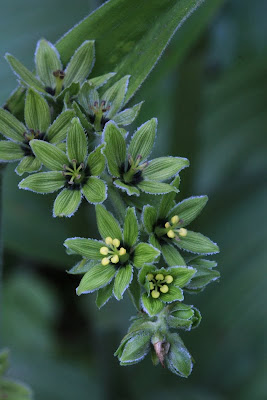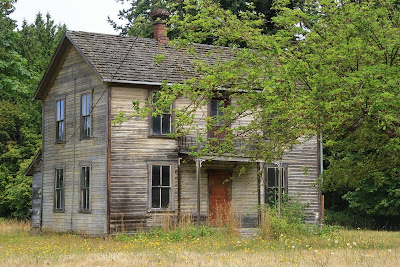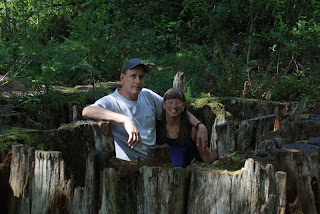These are some of my natural history ramblings, both literary and afoot, the result of a search for whatever there is to be found, including the native orchids and wildflowers of the beautiful state in which we live.
Saturday, August 24, 2013
The Olympics - Second Day
After spending the night in Port Angeles, the next day we headed for another area of the park up the Deer Park Road, a gravel road that took us some twelve miles up into the eastern side of the park.
We immediately found there another Piperia, the Slender White Piperia, Piperia candida. This was finished at lower elevations but here it was in bloom everywhere.
Growing with them we found the Pipsissewa, Chimaphilia umbellata and the Nodding Onion, Allium cernum, but the former was almost finished blooming.
We also found some Candystick, Allotrop virgata, on a steep bank and were perched precariously up there when another vehicle came down the one-lane road, forcing me to jump down off the bank.
Another new wildflower was the Columbia Goldenweed, Ericameria resinosa, with its very strange flowers, sticky stems and strong odor.
Others were Harsh Paintbrush, Broad-leaved Penstemon, Penstemon ovatus, Subalpine lupine, Lupinus arcticus, the massive Corn Lily, Veratrum viride, and Cascades Stonecrop, Sedum divergens.
Once we got above the treeline the scenery was spectacular especially at the very end of the road at the top of Blue Mountain. We wish now that we had done the trail there, but did not for lack of time.
On the way down we found our eleventh orchid, the Northwestern Twayblade, Listera banksiana, a tiny plant with tiny green flowers, here so close to the roads that plant and flowers were dusty.
There seemed to be a lot more deer than we've seen before and we photographed a doe with two fawns, though one of them bounded off before the picture was taken.
Nearby we found Pinedrops, Pterospora andromeda, a rather common leafless plant in the northwest forests, but these were massive, more than half as tall as my wife.
With them were growing another leafless saprophyte, Pinesap, Monotropa hypopithys, but they were nearly finished flowering.
We made a few stops, too on the way back to the ferry and home, one to photograph an old and apparently abandoned house near the road.
Monday, August 19, 2013
The Olympics - First Day
The last day of July and the first day of August we spent in the north part of Olympic National Park orchid hunting, something we do around that time every year.
We found plenty of orchids but also found that the season was much much farther along than usual with some species already finished nearly two weeks ahead of their usual blooming time.
However, the Olympics are worth visiting for the scenery as well as the orchids and we had a very good two days there, staying overnight in Port Angeles on the north side of the park.
We began our trip, after the ferry ride from Coupeville to Port Townsend and a short drive to Port Angeles, at Crescent Lake where we looked for two orchids along the shore of the lake.
One of the orchids is the Stream Orchid or Chatterbox (for its moveable lip), Epipactis gigantea. It was well past its prime but we found plenty of decent flowers left to photograph.
The other, the Elegant Piperia, Piperia elegans, was also past its prime but still nice and we not only photographed it but a crab spider lurking on one of the flower spikes.
I've recently been trying to become more expert in identifying native trees and this I believe is the Douglas Fir, also photographed at Crescent Lake, as was the Cluster Thistle.
From there we headed up the Elwha Valley where a dam is being removed and the area restored to its natural state. There we hiked the Humes Ranch trail to several abandoned homesteads.
Near one of the cabins I was able to get pictures of a Juba Skipper, Hesperia juba, on a Cluster Thistle. Also somewhere nearby we photographed the wildflower, Pipsissewa, as well.
This was an area of the park we had not visited before. We very much enjoyed a beautiful day and the hike through the open forest above the Elwha River.
On our way out we stopped for another brief hike to Madison Falls, but photography was very difficult there on account of the bright sunlight and deep shadows
Later in the day as the weather began to change we visited Hurricane Ridge and to see the orchids, scenery and wildflowers there. There, too, we found the season well advanced.
We stopped first to see the long-spurred variety of the White Bog Orchis, Platanthera dilatata var. leuchostchys (we would also see another variety of this species).
The Slender Bog Orchis, Platanthera stricta, was finished in most places but near the top of Hurricane Ridge we found some good specimens.
In the same area we found a few plants of a hybrid of the previous two species, the White Bog Orchis and the Slender Bog Orchis, Platanthera x estesii, with its whitish-green flowers.
At the next stop I was able to get photos of the Field Crescent, Phyciodes campestris. We spent quite a bit of time at this stop for the orchids and other wildflowers.
There were more of the White Bog Orchis, the long-spurred variety and the medium-spurred variety, Platanthera dilatata var. dilatata.
We also found the Great Hedge-nettle, Stachys chamisonis var. cooleyae, The carnivorous Common Butterwort, Pinguilcula vulgaris, and the Seep-spring Monkey-flower, Mimulus guttatus.
One wildflower I had not seen before was the very tall Mountain Larkspur, Delphinium glaucum, with its very dark, not widely-opened flowers.
Another beauty new to me was the Yellow Fireweed, Epilobium luteum, which we found growing in wet areas and so pale that the reference to "yellow" did not seem correct.
We also found a few of the Cascades Penstemon, Penstemon serrulatus, still blooming, but these, too, were showing signs of age.
Near the top and at the top of Hurricane Ridge we found another orchid, the Alaskan Piperia, Piperia unalascensis, in its dwarf form found only in this area.
The wildflowers were at their best at the top of Hurricane Ridge and we photographed there the Harsh Paintbrush, Castilleja hispida and the Pearly Everlasting, Anaphalis margaritacea.
Another new species for me was the Mountain Owl's Clover, Orthocarpus imbricatus, spectacularly beautiful and everywhere at the top of Hurricane Ridge.
Others were the common Harebell, Campanula rotundifolia, Common Yarrow, Achillea millefolium, Western Bistort, Polygonum bistortoides and the Olympic delphinium, Delphinium glareosum.
The Columbia Lily, Lilium columbianum, also grows in abundance at the top of Hurricane Ridge, but in a very dwarf form. These, too, were still blooming.
We also took photos of the Mountain Hemlock with its beautiful purple cones, in this case exuding sticky crystals of sap. These too were growing at the top of Hurricane Ridge.
My wife was able to get quite a few pictures of Black-tailed Deer, but since we were in an area where I could not leave the car, I had to be satisfied with her pictures.
Subscribe to:
Comments (Atom)

















































































































